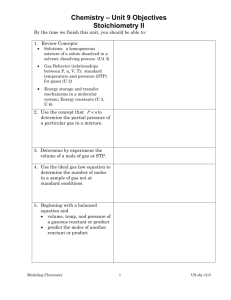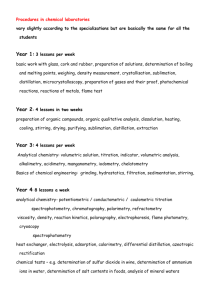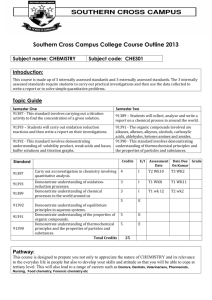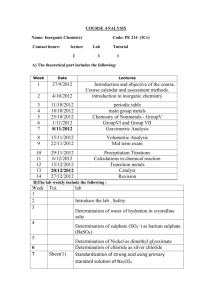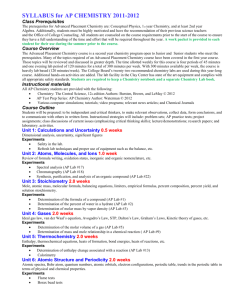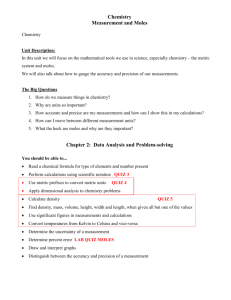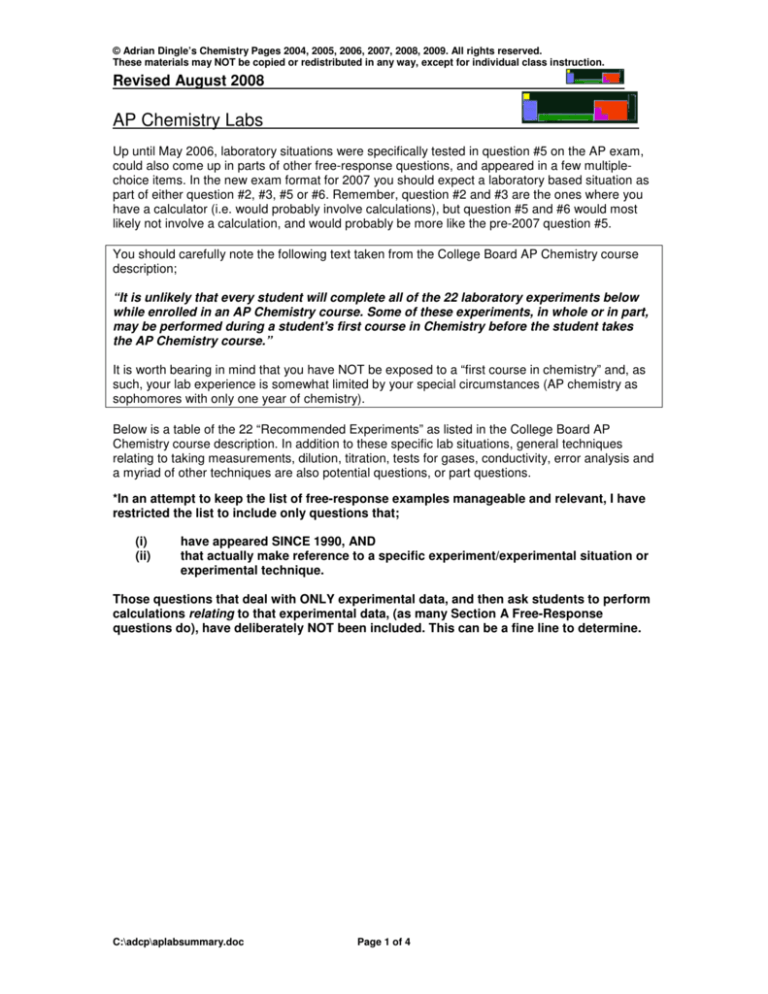
© Adrian Dingle’s Chemistry Pages 2004, 2005, 2006, 2007, 2008, 2009. All rights reserved.
These materials may NOT be copied or redistributed in any way, except for individual class instruction.
Revised August 2008
AP Chemistry Labs
Up until May 2006, laboratory situations were specifically tested in question #5 on the AP exam,
could also come up in parts of other free-response questions, and appeared in a few multiplechoice items. In the new exam format for 2007 you should expect a laboratory based situation as
part of either question #2, #3, #5 or #6. Remember, question #2 and #3 are the ones where you
have a calculator (i.e. would probably involve calculations), but question #5 and #6 would most
likely not involve a calculation, and would probably be more like the pre-2007 question #5.
You should carefully note the following text taken from the College Board AP Chemistry course
description;
“It is unlikely that every student will complete all of the 22 laboratory experiments below
while enrolled in an AP Chemistry course. Some of these experiments, in whole or in part,
may be performed during a student's first course in Chemistry before the student takes
the AP Chemistry course.”
It is worth bearing in mind that you have NOT be exposed to a “first course in chemistry” and, as
such, your lab experience is somewhat limited by your special circumstances (AP chemistry as
sophomores with only one year of chemistry).
Below is a table of the 22 “Recommended Experiments” as listed in the College Board AP
Chemistry course description. In addition to these specific lab situations, general techniques
relating to taking measurements, dilution, titration, tests for gases, conductivity, error analysis and
a myriad of other techniques are also potential questions, or part questions.
*In an attempt to keep the list of free-response examples manageable and relevant, I have
restricted the list to include only questions that;
(i)
(ii)
have appeared SINCE 1990, AND
that actually make reference to a specific experiment/experimental situation or
experimental technique.
Those questions that deal with ONLY experimental data, and then ask students to perform
calculations relating to that experimental data, (as many Section A Free-Response
questions do), have deliberately NOT been included. This can be a fine line to determine.
C:\adcp\aplabsummary.doc
Page 1 of 4
© Adrian Dingle’s Chemistry Pages 2004, 2005, 2006, 2007, 2008, 2009. All rights reserved.
These materials may NOT be copied or redistributed in any way, except for individual class instruction.
Revised August 2008
Suggested Lab
1. Determination of the formula of
a compound
2. Determination of the
percentage of water in a hydrate
3. Determination of molar mass
by vapor density
4. Determination of molar mass
by freezing-point depression
5. Determination of the molar
volume of a gas
6. Standardization of a solution
using a primary standard
7. Determination of concentration
by acid-base titration, including a
weak acid or weak base
8. Determination of concentration
by oxidation-reduction titration
9. Determination of mass and
mole relationship in a chemical
reaction
C:\adcp\aplabsummary.doc
What’s it all about?
For example, taking a mass of
magnesium ribbon and heating it in air.
The magnesium would combine with the
oxygen to form magnesium oxide. The
mass after reaction can be determined,
and the difference is the mass of oxygen
reacted. Then perform a moles/ratio
calculation to determine the empirical
formula. Another example would be a
combustion analysis.
Heat a hydrated salt to constant mass by
driving off water of crystallization and
compare moles of water lost to moles of
anhydrous salt residue in order to find x
in, for example, the formula CuSO4.xH2O
Determining Molar Mass by vaporizing a
volatile liquid. Apply PV = n R T, and
mass
n=
Molar Mass
Add solute to solvent, observe depression
in freezing point, then apply;
mass of solute
Molar
Mass
of
solute
∆Tf = i kf
Mass of solvent in kg
Obviously boiling point elevation would be
an alternative.
A gas can either be simply be released
from a canister or produced by a reaction
and then collected, often over water.
Knowing the moles of gas and knowing
the volume, it is possible to determine
Molar Volume, i.e. the number of L per
mole. At s.t.p. the molar volume of any
gas is 22.4 L per mole. Look out for
calculations that require the subtraction of
water vapor pressure from total pressure
of gas collected above water.
Simple titration. Knowing the EXACT
molarity of one solution, perform a
titration to find the volume of the unknown
solution required, and via the ratio of the
balanced equation, find the molarity of the
unknown.
Simple titration. Knowing the EXACT
molarity of one solution, perform a
titration to find the volume of the unknown
solution required, and via the ratio of the
balanced equation, find the molarity of the
unknown. Knowledge of indicators useful.
Weak Acid versus weak base could use a
pH meter to determine the end point.
REDOX titration. Knowing the EXACT
molarity of one solution, perform a
titration to find the volume of the unknown
solution required, and via the ratio of the
balanced REDOX equation, find the
molarity of the unknown. Other variations
may include the ratio being the unknown.
An experiment could be conducted to
illustrate limiting reactant or % yield. For
example, adding 10 g of Fe to 10 g of
CuSO4 dissolved in water does NOT yield
10 g of products. Reacting ratios and
moles need to be considered via
balanced chemical equations.
Page 2 of 4
Example free-response
questions since 1990*
1990, 9
2000, 3b, 2008 2a-c
1991, 6
2000, 5
1995, 3e; 1999, 5
1998, 5; 2004B, 5;
2006, 5
1996, 6
1993, 3e; 2000, 3c;
2003B, 5, 2007, 5
2008B, 3
© Adrian Dingle’s Chemistry Pages 2004, 2005, 2006, 2007, 2008, 2009. All rights reserved.
These materials may NOT be copied or redistributed in any way, except for individual class instruction.
Revised August 2008
Suggested Lab
10. Determination of the
equilibrium constant for a
chemical reaction
11. Determination of appropriate
indicators for various acid-base
titrations; pH determination
12. Determination of the rate of a
reaction and its order
13. Determination of enthalpy
change associated with a
reaction
14. Separation and qualitative
analysis of cations and anions
15. Synthesis of a coordination
compound and its chemical
analysis
16. Analytical gravimetric
determination
17. Colorimetric or
spectrophotometric analysis
C:\adcp\aplabsummary.doc
What’s it all about?
By determining the number of moles
present in an equilibrium mixture (by
titration or other quantitative method like
using a spectrophotometer), and knowing
the K expression, K can be determined.
Know that suitable indicators for acid
base titrations must change color in the
vertical portion of the titration curve. In
the past it has not be necessary to know
specific indicators and their colors, rather
just select a suitable one form a list.
Measure rate of reaction (time taken for
reactants disappear or products appear)
and then change one variable to examine
the change in rate. Analyze via equations
AND graphically. Also consider
determination of activation energy via
graph a possibility.
Mix solutions and measure temperature
changes. Temperature goes up,
EXOTHERMIC, temperature goes down,
ENDOTHERMIC.
q = m c ∆T (q can be shown as ∆H)
Recognizing the presence of certain ions
(and perhaps even non-ionic substances
as well via negative results) and
distinguishing between them via; flame
tests, precipitation reactions, colors,
chemical tests, solubility etc.
Making a compound and confirming its
chemical composition by performing
chemical and physical tests. See the
example free-response question for
examples of things that may be asked.
An experiment is carried out that yields a
solid (often a precipitate) that can be
dried and weighed. The mass can be
converted to moles in order find out many
other things via balanced chemical
equations and molar relationships.
Beer-Lambert Law.
Application of A = a b c.
Page 3 of 4
Example free-response
questions since 1990*
2006B, 5
2000, 8c; 2003, 1e
2005, 3; 2001, 6,
2004, 3e
2002, 5, 2003B, 3d
1992, 7; 1995, 5;
1995, 7c; 2001, 5c;
2002B, 5; 2004, 5;
2006, 5, 2008B, 5
2005B, 5
1997, 9, 2008 5d-e
2003, 5; 2006B, 5
© Adrian Dingle’s Chemistry Pages 2004, 2005, 2006, 2007, 2008, 2009. All rights reserved.
These materials may NOT be copied or redistributed in any way, except for individual class instruction.
Revised August 2008
Suggested Lab
What’s it all about?
Example free-response
questions since 1990*
Physical method used to separate
mixtures. Mixture is distributed into two
phases; a stationary phase and a mobile
phase. The mobile phase moves through
the stationary phase carrying the mixture.
Each component in the mixture will have
a different affinity for the stationary
phase. A high affinity for the stationary
phase means a component in the mixture
will not travel far. Less affinity causes a
component to travel further. The differing
distances traveled, results in separation.
The resulting separated bands are called
a chromatogram. Rf values can be
determined for each component;
Distance traveled by component
Rf =
Distance traveled by solvent
18. Separation by
chromatography
19. Preparation and properties of
buffer solutions
20. Determination of
electrochemical series
21. Measurements using
electrochemical cells and
electroplating
22. Synthesis, purification, and
analysis of an organic compound
C:\adcp\aplabsummary.doc
Mobile
Phase
Solvent
(water,
Paper
Paper
ethanol
etc.)
Solvent
Alumina or
(water,
Column
silica gel
ethanol
etc.)
Silica gel
Solvent
Thin
spread
(water,
Layer
thinly on
ethanol
etc.)
glass plate
An inert
gas
Gas
Liquid
carrying
Liquid
the
mixture
Making buffers by one of two methods;
(1) Either mix a weak acid and one its
salts or weak base an one of its salts to
create the buffer, or
(2) Partially neutralize a weak acid with a
strong base, or partially neutralize a weak
base with a strong acid. In each case the
weak component is left in excess, and the
salt is produced in situ.
Subsequent experiments can determine
small pH changes when buffers are
exposed to acids or bases.
Performing single displacement reactions
between metals and solutions. Metals
high in the activity series will displace
those below them from solution.
Experiments where electricity is passed
for a known time. Masses of solids
deposited can be determined by weighing
electrodes before and after, or volumes of
gases can be collected. In calculations
apply Q = I t, know that 1 F ≡ 96500 c,
and that 1 mol of electrons ≡ 1 F.
Make an organic compound by combining
reactants and subsequent purification
(filtering, re-crystallization etc.) followed
by analysis of the product (e.g.
combustion analysis, chemical tests).
Types
Stationary
Phase
Page 4 of 4
1992, 6b & d, 2007B
5c
1994, 5c
2005B, 2; 2003B, 6,
2007, 3


